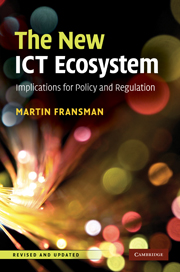Book contents
- Frontmatter
- Contents
- List of exhibits
- Preface
- List of abbreviations and acronyms
- Introduction
- 1 Summary of the argument
- 2 The new ICT ecosystem: architectural structure
- 3 The new ICT ecosystem as an innovation system
- 4 The new ICT ecosystem: a quantitative analysis
- 5 Telecoms regulation
- 6 Policy-making for the new ICT ecosystem
- 7 The way forward: the message to policy-makers and regulators
- Appendixes
- Bibliography
- Index
4 - The new ICT ecosystem: a quantitative analysis
Published online by Cambridge University Press: 04 May 2010
- Frontmatter
- Contents
- List of exhibits
- Preface
- List of abbreviations and acronyms
- Introduction
- 1 Summary of the argument
- 2 The new ICT ecosystem: architectural structure
- 3 The new ICT ecosystem as an innovation system
- 4 The new ICT ecosystem: a quantitative analysis
- 5 Telecoms regulation
- 6 Policy-making for the new ICT ecosystem
- 7 The way forward: the message to policy-makers and regulators
- Appendixes
- Bibliography
- Index
Summary
In order to throw further light on the working of the new ICT ecosystem we have constructed a database with information on 157 leading ICT companies divided according to the three layers in the layer model. Analysis of this data reveals, for example, the key contribution made by the networked element providers in layer 1 to the total amount of R&D undertaken in the ecosystem. It also highlights the importance of the network operators who provide the bulk of capital expenditure in the system. A further important finding is that the returns to telecoms operators in layer 2 is relatively lower than the returns to players in the other two layers.
The companies and their assignment to layers
In constructing our database, we selected the top 157 ICT companies (according to market capitalisation) from Thomson Financial. A second source was also used: UBS. We then allocated these companies to the three layers in the ICT ecosystem. The outcome of this procedure and the classifications we have used are shown inexhibit 4.1.
As can be seen fromexhibit 4.1, layers 1, 2 and 3 contain 54, 50 and 53 companies, respectively. Layer 1 companies are broken down into two further categories (in sub-sectors A); IT companies (which include system software providers) and telecoms equipment companies. It should be noted that some companies are included in both categories. The IT and telecoms equipment companies are broken down (in sub-sectors B) into European, US and Asian companies.
- Type
- Chapter
- Information
- The New ICT EcosystemImplications for Policy and Regulation, pp. 55 - 71Publisher: Cambridge University PressPrint publication year: 2010



